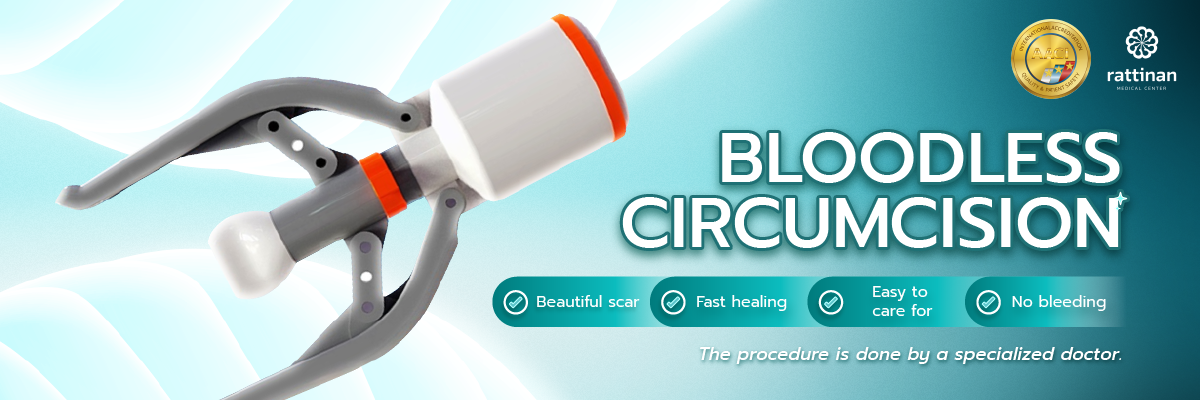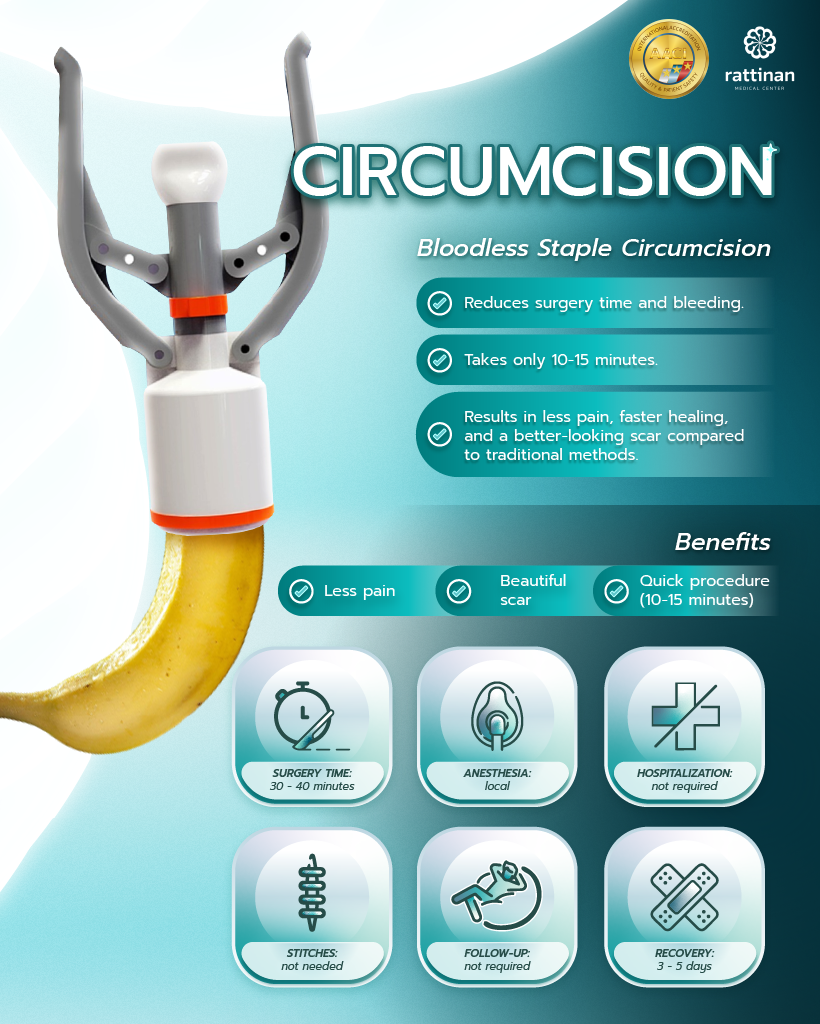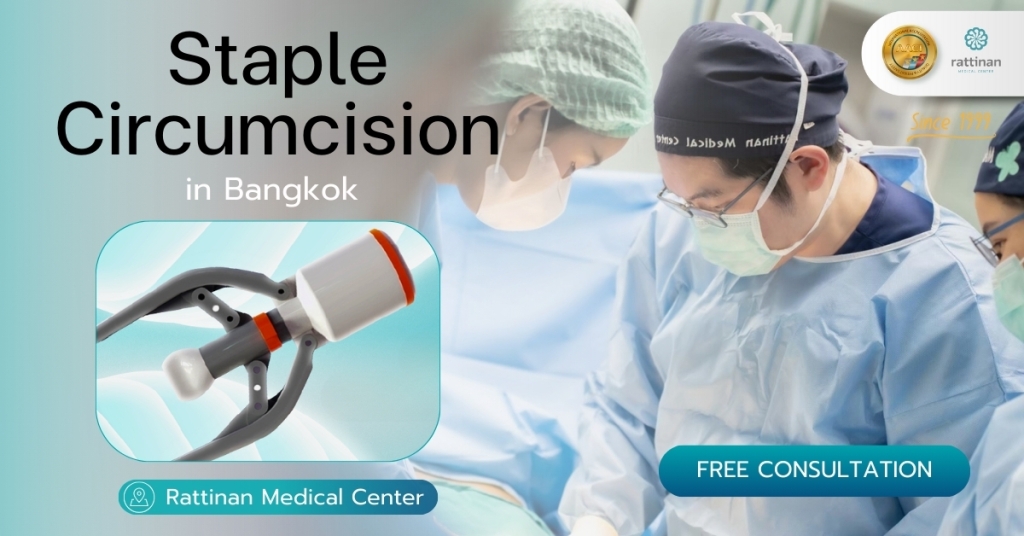Staple Circumcision in Bangkok, Thailand is a modern circumcision method offering a quick, safe, and effective alternative to traditional techniques. Using advanced stapling technology, it minimizes bleeding, reduces scarring, and ensures faster recovery, making it an ideal choice for men seeking a comfortable circumcision experience.
Bangkok has become a leading destination for staple circumcision due to its high medical standards, advanced technology, and affordable care. At Rattinan Medical Center, our expert surgeons are skilled in performing this procedure with precision and care, prioritizing safety and patient satisfaction.
What is Staple Circumcision?

Staple circumcision uses a specialized stapling device to remove the foreskin with greater precision than traditional methods. Unlike conventional techniques that involve cutting with a scalpel and suturing, the stapling device cuts and closes the wound simultaneously, reducing procedure time and complications.
Overview of the Stapling Method:
- Quick and Minimally Painful: The procedure usually takes less than 15 minutes and causes less trauma to surrounding tissues.
- Faster Recovery: Staples securely close the incision, promoting better healing and reducing infection risk.
Key Benefits of Staple Circumcision:
- Low Risk of Bleeding: The stapling device seals blood vessels, greatly reducing bleeding.
- Minimal Scarring: Precision cutting ensures a clean result with minimal scarring.
- Improved Hygiene: Removing the foreskin helps keep the penis clean, reducing the risk of infections.
Why Choose Staple Circumcision in Bangkok, Thailand?
Bangkok is a premier medical tourism hub known for high-quality healthcare at affordable prices. The city’s world-class standards, advanced technology, and skilled professionals make it an ideal destination for staple circumcision.
- Cost-Effective: Procedures in Bangkok are significantly more affordable than in Western countries, providing excellent value without compromising on quality.
- Accessible and Modern Facilities: Bangkok’s clinics and hospitals meet international standards, ensuring a seamless experience for patients.
Rattinan Medical Center offers top-notch care, with state-of-the-art technology and a patient-centered approach that prioritizes safety, comfort, and satisfaction.
Benefits of Staple Circumcision

Staple circumcision is preferred for its numerous health and procedural benefits:
Health Benefits:
- Reduces Infection Risks: Lowers the likelihood of UTIs and STIs, including HPV and HIV.
- Prevents Foreskin Issues: Effectively treats phimosis, paraphimosis, and balanitis.
Procedure Benefits:
- Quick Procedure: Typically completed in 10-15 minutes.
- Lower Risks: Reduced bleeding, pain, and scarring compared to traditional methods.
- Faster Recovery: Patients can resume normal activities sooner, with minimal downtime.
Who Should Avoid Staple Circumcision?
Staple circumcision isn’t suitable for everyone. Avoid this procedure if you have:
- Penile Deformities: Conditions like hypospadias or epispadias.
- Infections: Active foreskin or penile infections should be treated first.
- Anticoagulant Use: Blood thinners increase bleeding risks during surgery.
- Uncontrolled Chronic Conditions: Conditions like unmanaged diabetes or heart disease.
Always consult with a qualified urologist to ensure staple circumcision is right for you.
How Staple Circumcision is Performed at Rattinan Medical Center
At Rattinan Medical Center, staple circumcision is designed to be safe, comfortable, and efficient:
Pre-Procedure Preparation:
- Consultation: Discuss your medical history, expectations, and any concerns.
- Eligibility Assessment: Thorough evaluation to ensure you’re fit for surgery.
During the Procedure:
- Step-by-Step: The foreskin is removed with a stapling device that seals the incision simultaneously.
- Anesthesia: Local or topical anesthesia is used for minimal discomfort.
Post-Procedure Care:
- Recovery Guidelines: Detailed instructions on wound care and medications.
- Activity Restrictions: Avoid strenuous activities for 2-4 weeks.
- Follow-Up Visits: Return in 10-14 days to monitor recovery and remove staples.
Recovery from Staple Circumcision
- Healing Time: Initial healing within 2 weeks, full recovery in 4-6 weeks.
- Tips for Recovery: Maintain good hygiene, avoid heavy exercise, and manage discomfort with prescribed medications.
- Wound Care: Use creams like Fucidin to prevent infection and clean with solutions like Savlon.
Safety and Risks of Staple Circumcision
While generally safer than traditional methods, staple circumcision carries some risks:
- Common Risks: Mild swelling, minor bleeding, and temporary sensitivity.
- Comparative Safety: Lower complication rates compared to conventional circumcision.
- Safety Measures at Rattinan: Advanced techniques and expert surgeons minimize risks, with comprehensive pre- and post-op care.
Cost of Staple Circumcision in Bangkok, Thailand
Rattinan Medical Center offers cost-effective staple circumcision:
- Cost Range: 45,000 THB ($1332 USD).
- Comparison: More affordable than Western countries, where costs can exceed $2,500 USD.
- Financing Options: Flexible payment plans make the procedure accessible.
Why Choose Rattinan Medical Center?
- Safety and Technology: State-of-the-art facilities and advanced technology.
- Expert Surgeons: Highly experienced team with a patient-centered approach.
- Proven Satisfaction: Numerous testimonials from satisfied patients highlight our dedication.
Frequently Asked Questions (FAQs)
10-15 minutes.
Initial healing in 2 weeks, full recovery in 4-6 weeks.
Minimal scarring due to the precision of the stapling device.
Local anesthesia minimizes discomfort; pain is usually mild and manageable.
Reduced infection risks, improved hygiene, and prevention of foreskin-related issues.
Staple circumcision in Bangkok at Rattinan Medical Center provides a modern, safe, and effective option for men seeking circumcision. With advanced techniques, experienced surgeons, and a patient-focused approach, we ensure exceptional care from start to finish. Schedule your consultation today to take the next step towards improved penile health, hygiene, and confidence.


Our Expert Medical Contributors are licensed doctors and specialists who ensure every article is accurate, trustworthy, and easy to understand. Guided by our commitment to safety, care, and confidence, they provide expert insights to help patients make informed decisions. At Rattinan, we believe that knowledge is the first step to transformation.